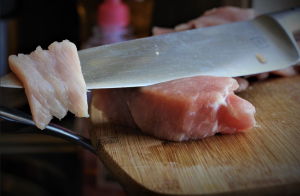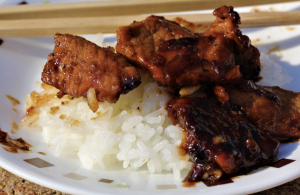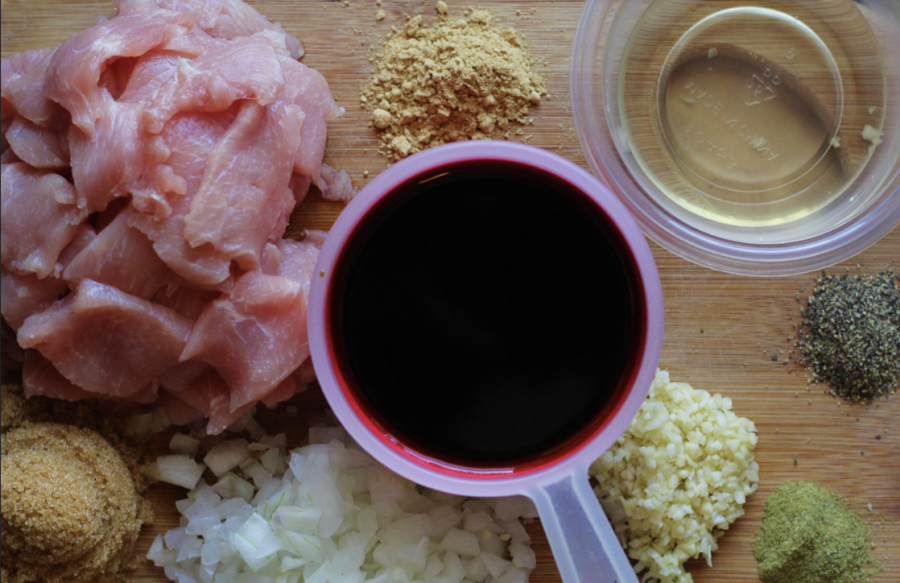Good Eatin’ on the Dime: Besting George Foreman’s lean, mean pork teriyaki foibles
As television audiences of the aughts know, one line of kitchen products’ infomercials stood out from all others. One lean, mean, fat burning market juggernaut grilling machine spawned a line of food prep paraphernalia — utensils, cookbooks, aprons, and everything else an aspiring home cook could want.
It was, of course, the George Foreman grill — a phenomenon in the realm of domestic cooking product promotion.
It’s estimated that, in the years since 1994, when the ex-boxing heavyweight world champion signed with the now defunct Salton Inc. — presiding over his name for use on the company’s new line of fat-reducing grills — has raked in upwards of $200 million in royalties and product bonuses.
No small chunk of income, “Mean George” has made considerably more on grills than he ever did in the ring, taking on the likes of Ali, Holyfield, Cooney, and Morrison.
Everybody owns a Foreman grill — frat boys, single moms, my arthritic, half-Sioux grandma, and, well, me. It’s a damn good machine in theory. Seer some cuts of meat, drain off the fat grease, and serve. Rinse and repeat.
I’ve found one major culinary flaw with the Foreman product line — its cookbooks. In particular, the “Lean, Mean, Fat Reducing Grilling Machine Cookbook,” published and co-authored by Foreman in 2000, yielded a couple of monotonous, flat-tasting dishes.
One such dish, the Grilled Teriyaki Pork Loin, gave me the idea to embark on a venture to improve on Foreman’s recipe by making it making it easier to cook and more enjoyable to taste. With a few tweaks, some adjustment of the ingredient minutiae, and an overhaul of the prep method, the pork loin can be whipped up with relative ease.
In the end, you’re left with a tangy, peppery stir fry that, when paired with white rice, is yet another affordable, hearty alternative to eating out.
For me, breaking the Foreman cookbook’s rules provided some insight into how making tweaks and bending a few guidelines is generally a good and honest approach to all things creative and otherwise.
Ingredients
3 8-oz. Pork Loins
½ Sliced Onion
1 tsp. Ground Ginger
1 1/2 tbsp. Brown Sugar
2 tbsp. Rice Vinegar
1 c. Soy Sauce
2 Finely Minced Garlic Cloves
2 c. Rice
1 tsp. Black Pepper
1 tsp. Salt
1 tsp. Thyme
1 tbsp. Olive Oil
Preparation
With a kitchen knife, slice your pork loin chops into long, thin, strips no more than about a fourth of an inch in thickness. Any chunkier on the loin and you risk cooking it unevenly or ending up with charred, flakey meat.

Slice one half of a white onion into slim, two to three-inch-long pieces.
Next, portion all the ingredients, placing the sliced onion, ginger, rice vinegar, soy sauce, garlic, black pepper, salt, thyme, and olive oil in separate portioning containers. I use measuring cups for this. If you have enough of them, that’s definitely the way to go for the ease of mixing them together.
Now it’s time to marinate the pork. In a medium-sized saucepan, add the sliced cuts of loin, soy sauce, ginger, vinegar, garlic, pepper, salt, and thyme. After thoroughly covering all meat in the resulting marinade, cover you pan and refrigerate for an hour.
At this point, you want to put the rice on to steam. In a rice pot, mix two cups of white rice and two cups of water. To yield a tender, palatable rice, you’ve got to rinse it in order to separate the germ from the kernel.
You can do this by first whisking the rice with your hand inside the pot. Then, after letting the rice soak in cold, shallow water, change out the water every 5 minutes and repeat the process three or four times.
Finally, set rice to steam until tender and slightly damp.
Once the pork loin is emanating a sweet, pungent odor, warm your stove-top burner to medium heat. Then, in a large, non-stick saucepan — I prefer ceramic, but hey, I’m a self-described anachronism of unnatural proportions — spread the olive oil and wait for the scent of savory, burning olives.
The last thing to do is cook it all up. Place the cuts of pork loin into the pan, spreading them evenly. Around the pork, pour remaining marinade, as it will act as a simmering sauce for the meat and onion.
After the stir fry reaches a steady boil, cover the pan and lower heat to just above medium. This will keep the marinade sauce from congealing into a thick paste and ruining the dish.
Just before covering, begin adding brown sugar in small increments. This will sweeten and thicken the teriyaki sauce into a syrupy mixture that smells thickly of thyme and soy, with a subtle background of spice, courtesy of the ginger.
Note that adding too much brown sugar at once can cause the sauce to congeal, again turning your food into a thick lump of grimy, inedible garbage.
Simmer until your pork is tender and brown, and serve over white rice, drizzling the dish with the remaining soy-ginger sauce.
Conclusions
In setting out to improve on a bit of a stock recipe in a now-aged cookbook, I undoubtedly found a newer, better, more delectable way to prepare and eat some strips of admittedly medium-quality pork loin.
In the end, the result was really quite good. The dish was spicy, to the point of watering the eyes, and includes just enough herb to maintain its savory flavor. Paired with rice, it provides a light, satisfying dinner entree. To boot, the ingredients are cheap as dirt.

The pork, herbs and rice have a cumulative price tag of no more than $7. What’s more, the recipe makes enough food to feed three people. Economy and taste are values this Teriyaki turned stir-fry does not sacrifice.
Rules beyond the food
Beyond food, something more meaningful occurred to me as I prepared the meat, gathered the accoutrements, and then chop-sticked bits of pork into my chompers.
After taking a list of ingredients and instructions and molding them into something I was more amenable to eating, it struck like lightning in a dry prairie storm. Rules in books — sets of prescribed missives, whether they be for cuisine preparation, building a pole barn, composing a quatrain, or conducting an orchestra, are meant to exist outside the vacuum in which we at times view ourselves as living in.
Simply, things can be done better — regardless of any rule an author in the past entrusted to the page in printed ink. Whether it be food or a way of living, the pork can always be herbed, marinated, simmered, served, and consumed from another parallax, from another line of sight.








